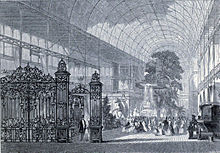
Back المعرض الكبير Arabic Gran Esposición AST Ümumdünya sərgisi (1851) Azerbaijani Сусветная выстаўка (1851) Byelorussian Сусьветная выстава (1851) BE-X-OLD Голямото изложение Bulgarian Gran Exposició Catalan Světová výstava 1851 Czech The Great Exhibition Danish Great Exhibition German
| 1851 London | |
|---|---|
 The Great Exhibition 1851 | |
| Overview | |
| BIE-class | Universal exposition |
| Category | Historical Expo |
| Name | 1851 London |
| Building(s) | The Crystal Palace |
| Area | 10.4 ha (26 acres) |
| Invention(s) | Telegraph, vulcanised rubber |
| Visitors | 6,039,722 |
| Location | |
| Country | United Kingdom of Great Britain and Ireland |
| City | London |
| Venue | Hyde Park, London |
| Coordinates | 51°30′11″N 0°10′12″W / 51.50306°N 0.17000°W |
| Timeline | |
| Opening | May 1 – October 15, 1851 (5 months and 2 weeks) |
| Closure | 15 October 1851 |
| Universal expositions | |
| Next | Exposition Universelle in Paris |






The Great Exhibition of the Works of Industry of All Nations, also known as the Great Exhibition or the Crystal Palace Exhibition (in reference to the temporary structure in which it was held), was an international exhibition that took place in Hyde Park, London, from 1 May to 15 October 1851. It was the first in a series of world's fairs, exhibitions of culture and industry that became popular in the 19th century. The event was organised by Henry Cole and Prince Albert, husband of Victoria, Queen of the United Kingdom.
Famous people of the time attended the Great Exhibition, including Charles Darwin, Karl Marx, Michael Faraday (who assisted with the planning and judging of exhibits), Samuel Colt, members of the Orléanist royal family and the writers Charlotte Brontë, Charles Dickens, Lewis Carroll, George Eliot, Alfred Tennyson, and William Makepeace Thackeray. The future Arts and Crafts proponent William Morris, then a teenager, later said he refused to attend the Exhibition on the grounds of taste.[1] The opening music, under the superintendence of William Sterndale Bennett, was directed by George Thomas Smart. Organised by Howard Staunton, the first international chess tournament took place at the Exhibition.[2] The world's first soft drink, Schweppes, was the official sponsor of the event.[3]
- ^ "Introducing William Morris". Victoria and Albert Museum. Retrieved 14 March 2023.
- ^ Murray, H.J.R. (November 1908). "Howard Staunton: part I". British Chess Magazine. Archived from the original on 8 December 2007. Retrieved 19 June 2008. and Murray, H.J.R. (November 1908). "Howard Staunton: part II". British Chess Magazine. Archived from the original on 8 December 2007. Retrieved 19 June 2008.
- ^ "Schweppes Holdings Limited". Royalwarrant.org. Retrieved 13 October 2021.
the world's first ever soft drink, Schweppes soda water [..] the official sponsor of Prince Albert's Great Exhibition in 1851